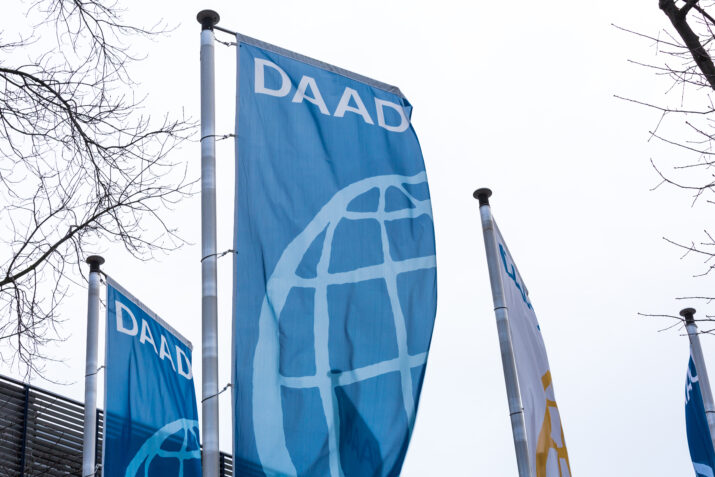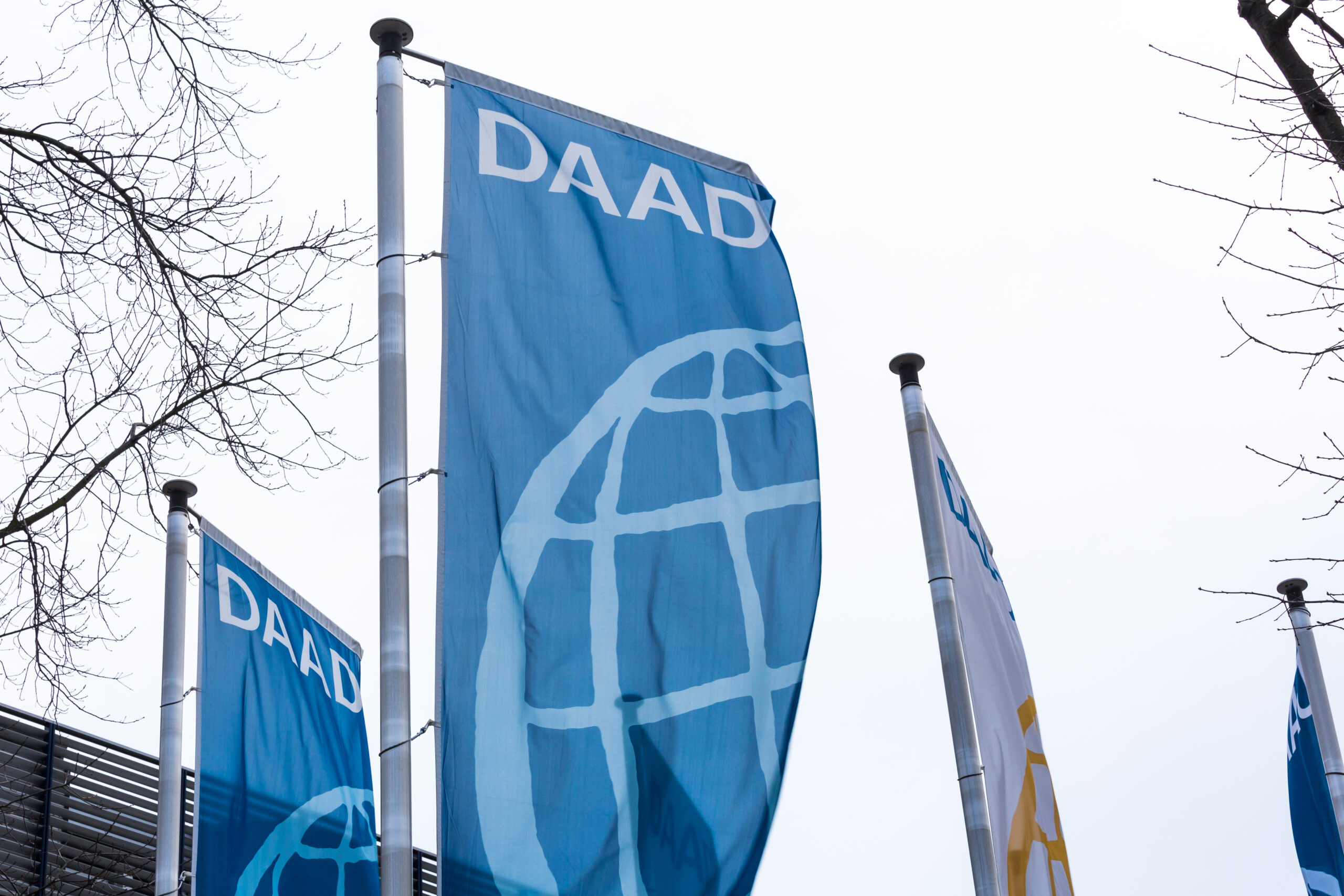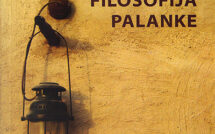
How German Higher Education Institutions Collaborate with Industry: The DAAD’s “Germany Today” Tour

The following seven, brief essays provide context for and key insights from an “informational tour” organized and sponsored by the Deutsche Akademische Austauschdienst (DAAD) (“German Academic Exchange Service”) in 2023. The tour of German universities took place in the Ruhr Valley, an historically significant industrial and increasingly important scientific and technological region. Participants, including the administrators and attendees who have contributed here, visited a variety of higher education institutions, research institutions, and companies in Bielefeld, the Ruhr area, Aachen, Düsseldorf, Cologne, and Bonn. While the focus of the “informational tour” was on institutions in Germany, the insights gained from these first-person encounters and the ensuing development of partnerships have significant implications for European Studies more broadly. Insights from private-public partnerships, with their efforts to address both financial and cultural challenges, can help institutions develop innovative initiatives and anticipate challenges. Each brief essay below provides context for the tour and illuminates findings that will be useful for administrators, staff, students, and faculty passionate about the future of European Studies and higher education.
Germany’s higher education landscape discovered with DAAD’s “Germany Today” information tour (by Uta Gaedeke and Christian Schäfer)
The German Academic Exchange Service (DAAD) offers an annual information tour aptly named “Germany Today,”[1] which provides a comprehensive overview of Germany’s higher education system. The program, established in 1979 and funded by the German Federal Foreign Office, aims to equip participants with a broad understanding of Germany’s educational landscape while fostering collaboration between international and German partners. This is motivated, in part, by the fact that Germany holds a significant position within the European Higher Education Area (EHEA), which consists of a diverse and interconnected network of higher education systems across Europe. Due to its size, resources, and rich tradition in scholarship and research, Germany serves as an excellent starting point for exploring the EHEA.
The tour-format is key to this initiative. The weeklong tour welcomes approximately 20 representatives emanating from universities, research institutions, funding agencies, and educational policy agencies in the United States and Canada. The tour serves as a platform for sharing best practices, effective methodologies, and valuable lessons learned in the realm of higher education. It also offers a comprehensive program that covers various aspects of Germany’s higher education and research system. Attendees have the chance to network and exchange ideas with their German counterparts and—not less relevant—with each other. Participants learn basic information about the German higher education system, but not only. The focus of the discussions is also on current developments in German higher education. For example, participants learn details about Bachelor’s, Master’s, and PhD programs offered at a range of institutions. Furthermore, they learn about funding opportunities for academic exchange and institutional cooperation, which constitutes essential information for anyone looking to engage with German universities. Thus, this immersive tour experience not only provides valuable practice-oriented knowledge but also fosters collaboration and strengthens ties between international and German institutions. Participants can establish new partnerships or deepen existing ones, which enables fruitful cooperation between educational organizations.
Importantly, this DAAD initiative changes focus in response to new developments. Each year, the tour focuses on a specific theme that participants explore in depth. Previous editions have covered a range of engaging topics, including
- “Facing Today’s Societal Challenges: German Universities’ and Research Institutions’ Interdisciplinary, Interinstitutional, and International Approaches” in 2021,
- “German Higher Education Institutions and their Role as a Gateway to the European Higher Education Area” in 2022, and
- in 2023, “German Higher Education and their Collaboration with Industry,” which aimed to shed light on the dynamic relationship between German universities and the corporate sector.
The “Germany Today” information tour is thus a unique opportunity to witness firsthand the innovation, excellence, and collaboration that define Germany’s higher education landscape, while not concealing the challenges that universities face in a rapidly changing world. Attendees return to their home countries with valuable insights and having made valuable connections that will undoubtedly enrich their professional endeavors.
Cultural challenges and development opportunities (Thomas O. Haakenson)
The June 2023 informational tour organized by the Deutsche Akademische Austauschdienst (DAAD) focused on emerging and ongoing partnerships between private industries and public universities in Germany’s Ruhr Valley, an historically significant industrial region and polycentric conurbation in the western state of North Rhine-Westphalia. Bringing together approximately 20 educational administrators and academic leaders from Canada and the United States, the DAAD offered a glimpse not only of an educational system in transition but also of a formerly industrial area embracing exciting new foci: sustainable fuels, biotechnology, and environmentally conscious manufacturing. The tour as such spoke to positive, affirming ways to direct the global and neoliberal forces reshaping higher education across Europe.
There were a number of highlights during the whirlwind informational tour. Perhaps no other activity, however, spoke to concerns about cultural homogenization—exemplified in the use of English as a lingua franca in these partnerships—better than events at the Ruhr-Universität Bochum, the Universität Duisburg-Essen, and Technische Universität Dortmund. Leaders from these institutions offered diverse perspectives on the public-private collaborations as part of the second, full-day panel on “Diversity, Internationalization and University Culture.” While private-public collaborations and the desire for a socially-conscious, commercial avant-garde might be easily applied to other European educational contexts, the panel raised important issues and asked important questions about diversity, equity, and inclusion, all in the name of “culture.”
In his 1991 book Representation: Cultural Representation and Signifying Practices, Stuart Hall describes “culture” not only as “representation” but also “shared meaning.” This two-part definition may seem, on the surface, duplicative—and perhaps even duplicitous. It is not. For Hall, culture is the use of supposedly commonly understood signs and symbols (“language”) to stand for ideas, thoughts, feelings, expressions, and emotions (“culture”). The collapse of language (as forms of representation) fully into culture (as our “shared forms of meaning”) masks the very problematic homogenization of difference. The focus on English as a lingua franca as a way to bring together private industry partners and public university participants thus ultimately makes difference something to be eliminated, reduced, or avoided rather than engaged, celebrated, and amplified. Simply having a “common language” for research and development projects, as is the case in many of these otherwise impressive public-private partnerships, thus threatens to erase difference, to subsume cultural heterogeneity, under the auspices of a required, monolingual approach to research, to partnering, and to collaboration.
Representatives on the “Diversity, Internationalization and University Culture” panel spoke to this issue of cultural erasure and the need for difference, equity, and inclusion. Karen Shire of the Universität Duisburg Essen and her colleagues emphasized that cultural differences can create points of conflict but also opportunities for more holistic thinking. The panel, one of the most exciting of the trip for me, made clear that the universal use of English as a lingua franca should not serve to substitute for the role of culture in its various, highly beneficial forms.
Study abroad and exchange (Christine Mendand)
The return to campus, post-pandemic, brought about new challenges for universities, in terms of human resources:
- Sophomores and even juniors became “new” on-campus students, which meant that institutions welcomed twice as many students as in previous years for their first time on campus. This larger than normal “new on-campus” number persisted as students who had deferred the start of their studies continued to arrive on campus.
- Many students sought additional assistance. The return to in-person studies saw staff and faculty advising students on academic skill building, financial literacy, mental and physical wellness, and independence—areas students previously could handle on their own or had more growth in before arriving at the university. An increased number of family members also wanted to continue to be kept informed about and part of the decision-making process in their student’s college experience.
- Graduate students in one- or two-year programs had had fully remote degree experiences.
- There was a shortage of staff, due to the great resignation. This meant employees who remained were burdened with more obligations than typical. And those in new positions took on responsibilities previously undertaken by more seasoned staff.
These issues overall created a difficult balancing act: how to provide support, adjustment, and a strong learning environment while maintaining a healthy challenge in terms of academic, personal, and professional growth? I mention these aspects mainly to showcase the importance of building skill sets and growth opportunities within our academic communities. As we seek to educate tomorrow’s leaders, the burden cannot entirely be placed on academic institutions. Collaborations between university and industry partners are therefore necessary to provide opportunities for students to put learning into practice, acquire new skills personally and professionally and in their chosen field, and network with those in the industry, which will overall create a stronger, more prepared workforce. As the DAAD mentions on its website, providing these opportunities “contributes to ensuring that higher education is better adapted to the requirements and developments of the labour market.”
While we, at universities, provide support for students’ personal and academic growth, industries take that learning into the professional realm. By partnering with universities, industry partners gain
- access to new thoughts and ideas to stay relevant, and
- access to shared lab and other resources to remain fiscally responsible.
We cannot expect growth and experience to happen on their own. For higher education institutions, creating partnerships with the industries their graduates enter into is a beneficial strategy, which also benefits these industries.
Talent, knowledge, and innovation (Michael A. O’Neill)
The idea of the university as an ivory tower has long been replaced by that of the university as a vast reservoir of new talent, knowledge, and innovation. Whether public or private, North American universities fulfill their missions by striking a balance between their role as institutions of higher learning and research and their role in helping meet the requirements of the labor market and industry. To do this more effectively, North American institutions may want to look to the German higher education system for ideas.
The German higher education system has evolved to distinguish between universities—institutions of higher learning and research—and Hochschule—institutions of applied learning and research. This distinction has greatly influenced the Germans’ approach to academic programming, curriculum development, pedagogy, and faculty composition.
Hochschule and industry collaborations in Rhineland Westphalia
Part community college, part polytechnic, part university, Hochschule have no exact counterpart in North American higher education. They are uniquely placed to bridge the gap between academia and industry. A recent visit to Rhineland Westphalia provided key insights into the main features of German academic and industry collaborations. Foremost, work-integrated studies (WIS) (or cooperative education programs) are a central part of academic programs and a key part of curriculum delivery in Hochschule. Unlike similar programs in North America, these WIS revolve around formalized arrangements between Hochschule and their students. Completing several placements with the same employer over the course of their studies, students have a more holistic learning journey than those in the North American system. Students in Hochschule are often selected by an industry partner even before being admitted to their academic program, and their first term in higher education includes a WIS placement. Faculty also alternate between Hochschule and industry, thus enabling students undertaking research to combine work on projects in Hochschule and industry laboratories as part of their studies. Upon graduation, students typically remain with the companies where they were placed for their WIS, further solidifying relationships between Hochschule and their industry partners. For example, the collaborations Hochschule Bielefeld has developed with German multinational firms have become a cornerstone of its student recruitment strategy.
Several Hochschule also proactively pursue initiatives to transition their academic research to the marketplace by hosting technology transfer centers. These centers provide services and assistance to nurture the business ideas that spring from the work of students and faculty. For example, the Technische Universität Dortmund’s Center for Entrepreneurship & Transfer and the Collective Incubator, affiliated with RWTH Aachen University, combine training, extensively equipped fabrication spaces, and spaces for meeting and working. These technology transfer centers are financially supported by both the federal and Länder governments with funds that are separate from those allocated for teaching and research, which reduces or removes the overhead costs that can hinder start-ups. For instance, the Bochum biotechnologies cluster provides start-up and established firms with access to facilities for 90 €/month for up to eight years. The cluster has also become a magnet for large multinational companies and small- to medium-sized enterprises to develop their networks and research and market collaborations. The model of support for commercialization of research also includes government financial aid for registering any IP arising from research conducted in Hochschule, with them gaining a stake in any downstream revenue generated from the IP. This structure fosters faculty and student participation in both academic and business endeavors.
A unique model with reproducible features
While Hochschule are a type of institutions without a parallel in North America, their role in encouraging partnerships between universities and industry have several reproducible features relevant to North American business and academic leaders. Notably, greater formalization of WIS agreements between universities and industries would increase the relevance of these programs to both students and the industries that employ them. Though some university leaders may resist aligning curriculum and pedagogy to labor market requirements, Hochschule demonstrate how this approach can be beneficial to students and employers—and ultimately to academic institutions. Similarly, the experience of Hochschule in hosting or affiliating with business incubators encourages entrepreneurship by removing or reducing obstacles that discourage students and faculty from taking their new ideas to markets. It could be argued that these features exist because of the unique political and economic culture of Germany, but the adoption of these features in North America could build on practices that are already present in many universities there.
STEM opportunities (by Frank Peters)
High impact practices, such as service-learning, internships, and international experiences afford students tremendous opportunities to grow personally and professionally, whether in Germany, the US, or elsewhere. However, these practices must be fostered and supported in order to get many students to successfully engage. With a dual role as an engineering faculty member and as the study abroad center director at my home institution, I was particularly intrigued about how German institutions strongly support international experiences for STEM students. During the DAAD “Germany Today” tour, we witnessed international internships in action in the institutions we visited and saw excellent examples of the synergy of two very important high impact practices. Likely the most well-known opportunity in the US is the RISE program, which funds students from four countries to conduct research in German universities. However, there are other examples of programs providing similar opportunities for US students to conduct research or intern at German entities. In addition, German parliamentary internships are available to US and Canadian students—STEM or not—with an interest in improving how democracies operate. Enabling a student from another country to have a pathway to engage in an international work opportunity is certainly noteworthy, but these programs go beyond the offering of possibilities, as they also provide financial support. Through the DAAD tour, we also learned about institutions that have established programs similar to RISE to enable German students to engage in international work experience, and again with funding provided by a particular German institution. Another point of interest during the visit was learning about the working internship program, which integrates study periods with work sessions at a single company. A few engineering programs in the US have required that students participate in internships to graduate; however, the German program requires students to be accepted both by the company and the school prior to even enrolling. While the system is quite rigid in its requirements, it was encouraging to learn that students can nonetheless switch their area of study and retain the ability to continue in the integrated internship program, albeit they are responsible for the specific work assignments aligned to their new major.
Whether in the US, Germany, or elsewhere, a college degree should be a useful accomplishment for people as they move into their careers. Course requirements should be only a small part of the college experience. Engagement with high impact practices is critical for students to get the best experience to propel their personal development and professional careers, especially for STEM majors who are sometimes distracted by the rigors of their courses to fully engage. The opportunities that German institutions afford students from Germany and other countries to engage in international work experiences is remarkable.
Entrepreneurship, tech transfer, and partnerships (by Angela Wilson)
The 2023 DAAD Science Tour provided an excellent overview of entrepreneurship, tech transfer, and partnerships between universities and industry in Germany. Major investments in the applied universities have been made by the German government to enable universities to host well-equipped and well-staffed innovation spaces as well as large-scale incubator centers for new start-up companies. As a result, the resources available to students with an entrepreneurial mindset is significant. During the tour, close partnerships between universities and companies were highlighted, with partnerships in Germany involving more than 300 industrial partners, including a very significant number of start-up companies that have resulted from previous tech transfer from these private collaborations with applied universities. It is clear that an outstanding climate for innovation and for the development of modern-day opportunities for the future workforce has been created in Germany—opportunities that will interest today’s students globally.
With the recent launch of the US National Science Foundation’s Technology, Innovation and Partnerships (TIPS) Directorate, the various German models of innovation centers, tech transfer, and university-industry partnerships provide the US with some brilliant examples of practices that could be very effective as the US strives to accelerate the development of technologies via new investments. Most of the new investments made in the US will be short-term in nature; therefore, the sustainability of programs in innovation must be sought. The general climate at many US universities will have to change to shift towards increased prioritization of innovation and tech transfer. While the university structures in Germany and the US differ, an innovation mindset is important for all types of universities. How German universities have accomplished these shifts, and how they are addressing the sustainability of their programs provide vital examples of success.
Innovation and corporate strategy (by Amy Bridger)
Cultivating creativity is a continuous process that requires persistence and an open mindset. Even when immersed with (or surrounded by) people who foster a creative mindset, a routine context can create mind blocks, which can be alleviated when we take breaks or step away from that routine. Such breaks can provide mental clarity and rejuvenation. Personally, these moments often allow me to avoid the trappings of everyday pressures and to brainstorm or map pathways to solutions that had not previously been evident. When I participate in one of these opportunities for breaks in my routine, I often return home with a full notebook. There are notes directly relating to what I have experienced. In the margins, however, there are almost always equal amounts of sketches and unanswered questions, where I brainstorm on challenges unrelated to the event.
Each year, the DAAD gathers practitioners of similar ilk from North America and brings them to Germany for discussions, tours, and opportunities to develop collaborative initiatives. In 2023, DAAD awarded me a coveted seat on a week-long tour through southwestern Germany to study university-industry engagements alongside 21 other colleagues. The experience allowed me to embrace my curiosity about—and borderline obsession with—these types of partnerships. Curiosity drives continual improvement and increased relevance of my day-to-day work, including my responsibility for a university-industry research park where more than 500 employees from 21 tenant companies engage in various ways across the college.
Since the tour, I have continued to review my notebook. The creativity margins provide me with numerous unrelated ideas or visualizations—such as purchasing e-bike attachments for users of manual wheelchairs on campus and in the Knowledge Park. As I toured Aachen, I saw a gentleman traversing the campus with such an attachment. I had not known about such devices, but I quickly sent the idea to our product development laboratory to assess for implementation. By the time I returned home, that idea had already been implemented and begun to help those in manual wheelchairs traverse our college, which is built on a hill with a 15+ percent incline grade. Behrend purchased five Firefly 2.5 e-bike attachments, which are being given away free to any full-time student, employee, or Park tenant. Our first candidate is an employee in our Park. The attachment will be installed by student employees in the James R. Meehl Innovation Commons, a rapid prototyping and product development lab at Behrend. This creates a tangible investment by the college and our student workers to make Behrend more accessible, which I hope will encourage enrollment and retention of those with mobility challenges.
Opportunities such as the DAAD’s “Germany Today” trip are worth their weight in gold. They forge new connections, new perspectives, and new ideas. The sketches in the margins of my notebook can create one-off solutions to problems never thought of, finally giving space to nagging issues that never seem to rise to the top of the pile or unleashing creative energy to look beyond the obvious.
Amy Bridger is Senior Director of Corporate Strategy and External Engagement at Penn State Erie, The Behrend College.
Uta Gaedeke is a Program Officer with the Deutsche Akademische Austauschdienst (DAAD) (“German Academic Exchange Service”).
Thomas O. Haakenson is Treasurer at the German Studies Association. He is also Associate Professor in the Humanities & Sciences Department at the California College of the Arts.
Christine Menand is the Associate Director of the Office of International Education at Carnegie Mellon University.
Michael A. O’Neill is Directeur des politiques et de l’engagement stratégique / Director, Policy and Strategic Engagement at the Fondation canadienne pour l’innovation / Canada Foundation for Innovation.
Frank Peters is the Director of the Study Abroad Center and also Associate Professor and C.G. “Turk” and Joyce A. Therkildsen Professor of Industrial and Manufacturing Systems Engineering at Iowa State University.
Christian Schäfer is the Head of Section for the Department Strategy of Research and Studies with the Deutsche Akademische Austauschdienst (DAAD) (“German Academic Exchange Service”).
Angela K. Wilson is Associate Dean for Strategic Initiatives in the College of Natural Sciences as well as John A. Hannah Distinguished Professor of Chemistry at Michigan State University.
[1] https://www.daad.org/en/find-funding/faculty/germany-today/
Published on February 15, 2024.




